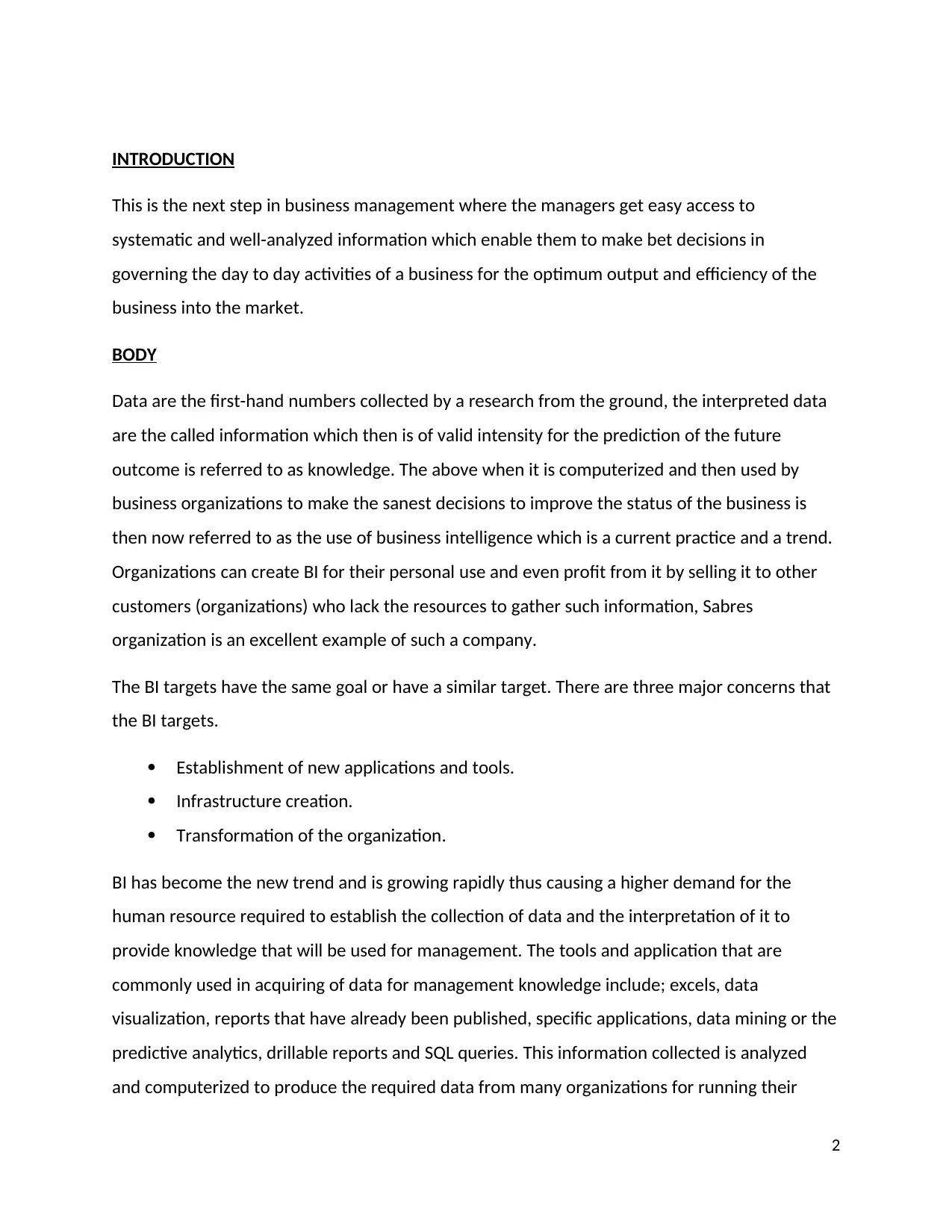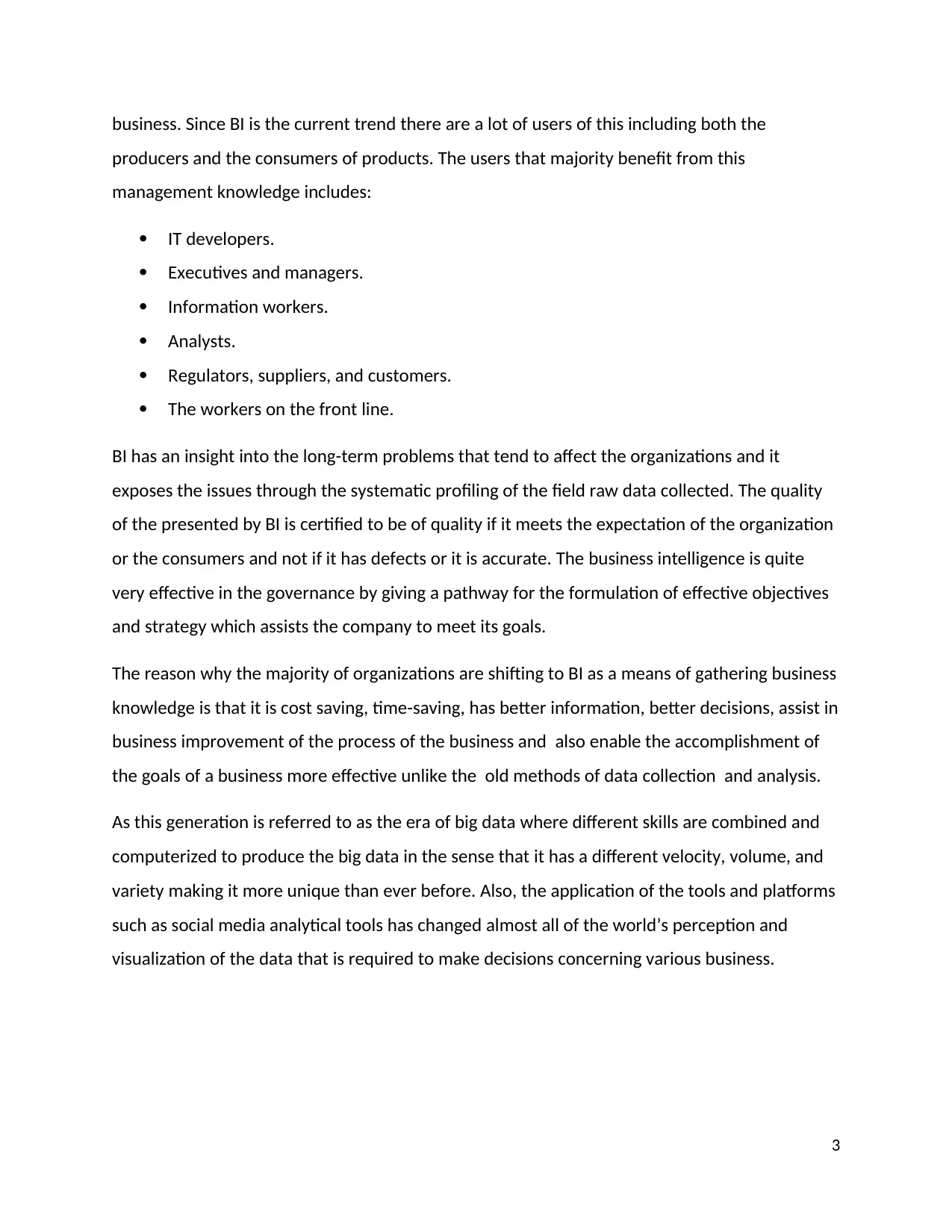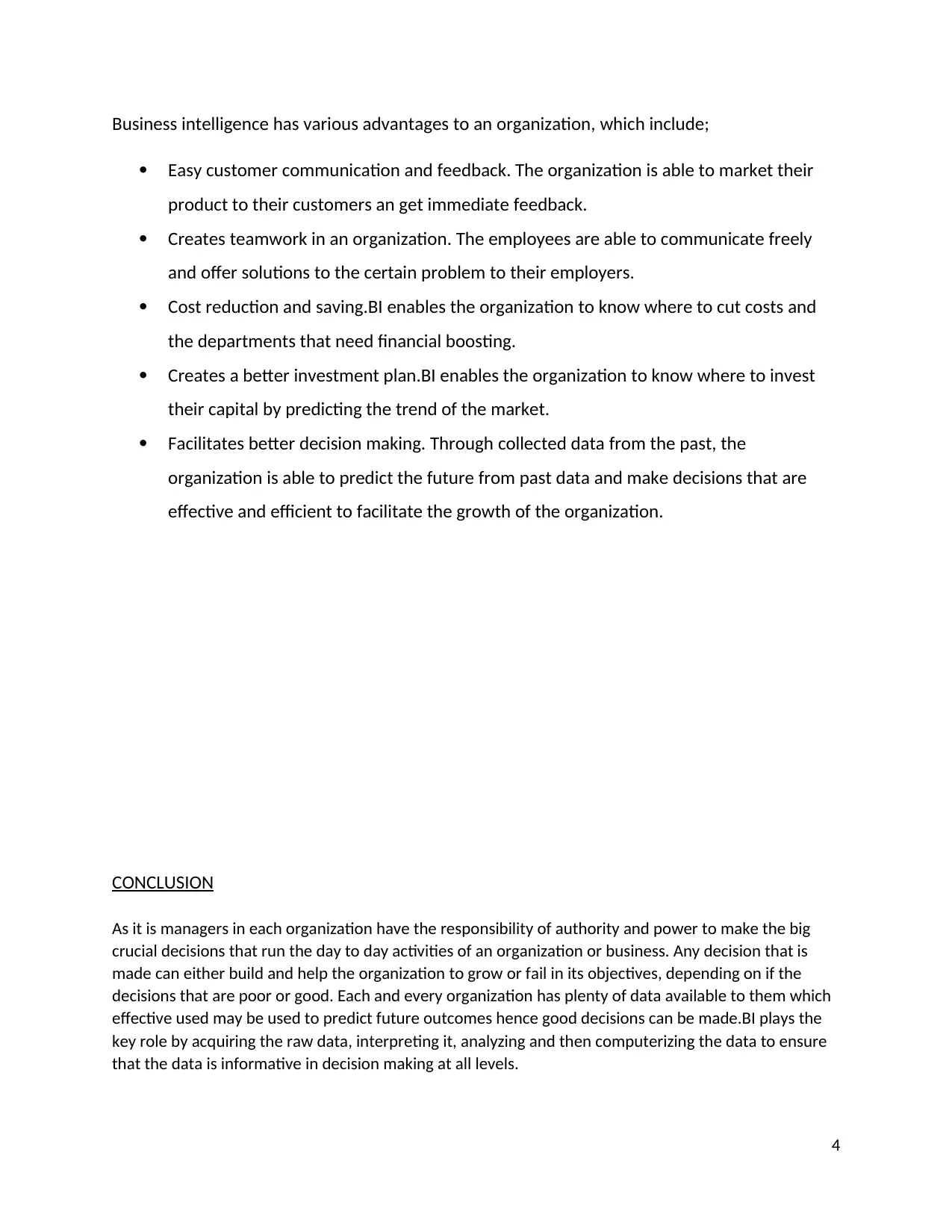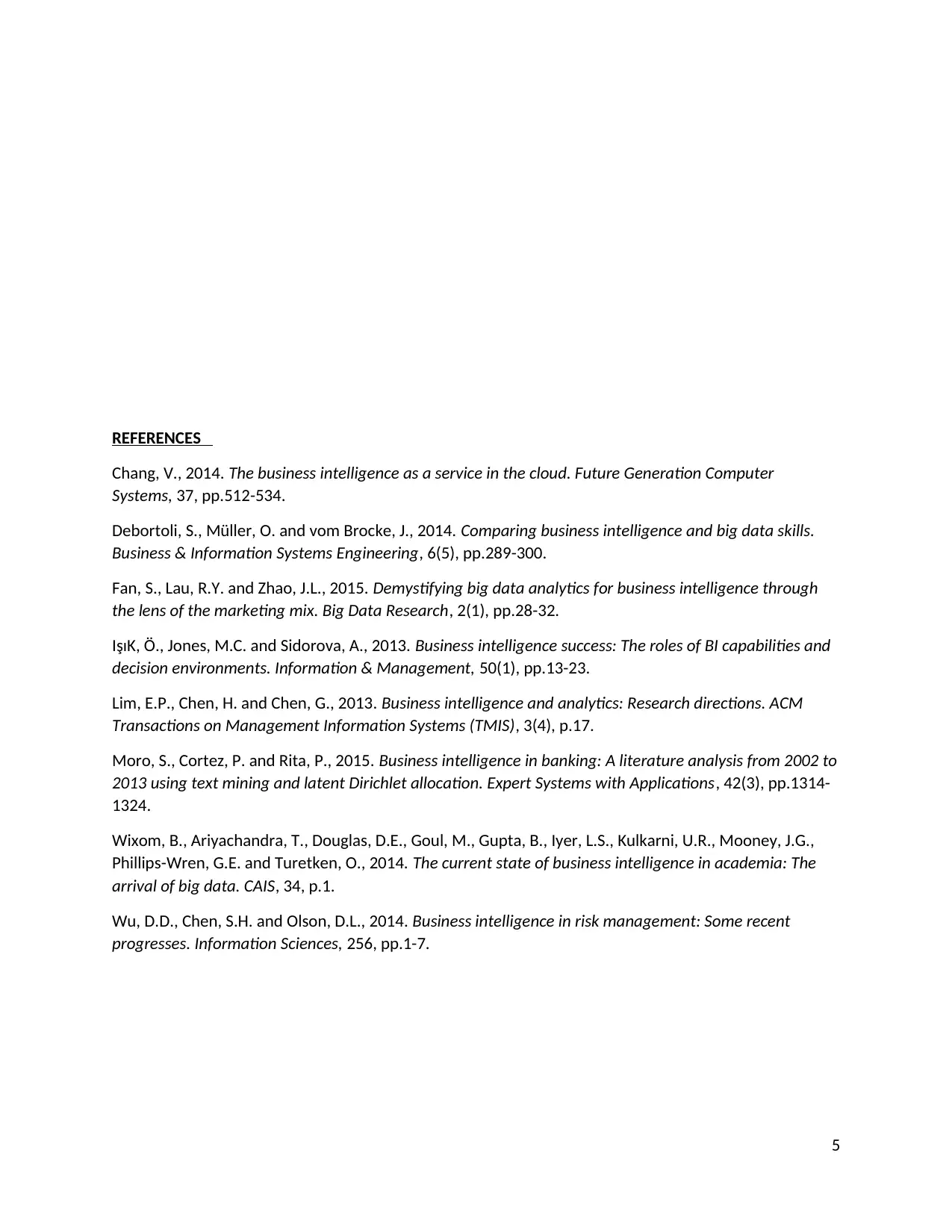Analyzing the Impact of Business Intelligence on Organizational Growth
VerifiedAdded on 2023/06/10
|5
|1239
|82
Essay
AI Summary
This essay provides a comprehensive overview of business intelligence (BI), highlighting its role in modern business management. It discusses how organizations leverage BI to access systematically analyzed information for improved decision-making, leading to optimized output and efficiency. The essay differentiates between data, information, and knowledge, emphasizing the importance of computerized BI in contemporary business practices. It outlines the key targets of BI, including establishing new applications, creating robust infrastructure, and facilitating organizational transformation. Furthermore, it identifies various users who benefit from BI, such as IT developers, executives, analysts, and front-line workers. The discussion extends to the advantages of BI, including enhanced customer communication, teamwork, cost reduction, better investment planning, and improved decision-making, concluding that BI offers a cost-effective and time-saving approach to achieving organizational goals in the era of big data.

BUSINESS INTELLEGINCE
NAME
INSTITUION AFFILIATION
1
NAME
INSTITUION AFFILIATION
1
Paraphrase This Document
Need a fresh take? Get an instant paraphrase of this document with our AI Paraphraser

INTRODUCTION
This is the next step in business management where the managers get easy access to
systematic and well-analyzed information which enable them to make bet decisions in
governing the day to day activities of a business for the optimum output and efficiency of the
business into the market.
BODY
Data are the first-hand numbers collected by a research from the ground, the interpreted data
are the called information which then is of valid intensity for the prediction of the future
outcome is referred to as knowledge. The above when it is computerized and then used by
business organizations to make the sanest decisions to improve the status of the business is
then now referred to as the use of business intelligence which is a current practice and a trend.
Organizations can create BI for their personal use and even profit from it by selling it to other
customers (organizations) who lack the resources to gather such information, Sabres
organization is an excellent example of such a company.
The BI targets have the same goal or have a similar target. There are three major concerns that
the BI targets.
Establishment of new applications and tools.
Infrastructure creation.
Transformation of the organization.
BI has become the new trend and is growing rapidly thus causing a higher demand for the
human resource required to establish the collection of data and the interpretation of it to
provide knowledge that will be used for management. The tools and application that are
commonly used in acquiring of data for management knowledge include; excels, data
visualization, reports that have already been published, specific applications, data mining or the
predictive analytics, drillable reports and SQL queries. This information collected is analyzed
and computerized to produce the required data from many organizations for running their
2
This is the next step in business management where the managers get easy access to
systematic and well-analyzed information which enable them to make bet decisions in
governing the day to day activities of a business for the optimum output and efficiency of the
business into the market.
BODY
Data are the first-hand numbers collected by a research from the ground, the interpreted data
are the called information which then is of valid intensity for the prediction of the future
outcome is referred to as knowledge. The above when it is computerized and then used by
business organizations to make the sanest decisions to improve the status of the business is
then now referred to as the use of business intelligence which is a current practice and a trend.
Organizations can create BI for their personal use and even profit from it by selling it to other
customers (organizations) who lack the resources to gather such information, Sabres
organization is an excellent example of such a company.
The BI targets have the same goal or have a similar target. There are three major concerns that
the BI targets.
Establishment of new applications and tools.
Infrastructure creation.
Transformation of the organization.
BI has become the new trend and is growing rapidly thus causing a higher demand for the
human resource required to establish the collection of data and the interpretation of it to
provide knowledge that will be used for management. The tools and application that are
commonly used in acquiring of data for management knowledge include; excels, data
visualization, reports that have already been published, specific applications, data mining or the
predictive analytics, drillable reports and SQL queries. This information collected is analyzed
and computerized to produce the required data from many organizations for running their
2

business. Since BI is the current trend there are a lot of users of this including both the
producers and the consumers of products. The users that majority benefit from this
management knowledge includes:
IT developers.
Executives and managers.
Information workers.
Analysts.
Regulators, suppliers, and customers.
The workers on the front line.
BI has an insight into the long-term problems that tend to affect the organizations and it
exposes the issues through the systematic profiling of the field raw data collected. The quality
of the presented by BI is certified to be of quality if it meets the expectation of the organization
or the consumers and not if it has defects or it is accurate. The business intelligence is quite
very effective in the governance by giving a pathway for the formulation of effective objectives
and strategy which assists the company to meet its goals.
The reason why the majority of organizations are shifting to BI as a means of gathering business
knowledge is that it is cost saving, time-saving, has better information, better decisions, assist in
business improvement of the process of the business and also enable the accomplishment of
the goals of a business more effective unlike the old methods of data collection and analysis.
As this generation is referred to as the era of big data where different skills are combined and
computerized to produce the big data in the sense that it has a different velocity, volume, and
variety making it more unique than ever before. Also, the application of the tools and platforms
such as social media analytical tools has changed almost all of the world’s perception and
visualization of the data that is required to make decisions concerning various business.
3
producers and the consumers of products. The users that majority benefit from this
management knowledge includes:
IT developers.
Executives and managers.
Information workers.
Analysts.
Regulators, suppliers, and customers.
The workers on the front line.
BI has an insight into the long-term problems that tend to affect the organizations and it
exposes the issues through the systematic profiling of the field raw data collected. The quality
of the presented by BI is certified to be of quality if it meets the expectation of the organization
or the consumers and not if it has defects or it is accurate. The business intelligence is quite
very effective in the governance by giving a pathway for the formulation of effective objectives
and strategy which assists the company to meet its goals.
The reason why the majority of organizations are shifting to BI as a means of gathering business
knowledge is that it is cost saving, time-saving, has better information, better decisions, assist in
business improvement of the process of the business and also enable the accomplishment of
the goals of a business more effective unlike the old methods of data collection and analysis.
As this generation is referred to as the era of big data where different skills are combined and
computerized to produce the big data in the sense that it has a different velocity, volume, and
variety making it more unique than ever before. Also, the application of the tools and platforms
such as social media analytical tools has changed almost all of the world’s perception and
visualization of the data that is required to make decisions concerning various business.
3
⊘ This is a preview!⊘
Do you want full access?
Subscribe today to unlock all pages.

Trusted by 1+ million students worldwide

Business intelligence has various advantages to an organization, which include;
Easy customer communication and feedback. The organization is able to market their
product to their customers an get immediate feedback.
Creates teamwork in an organization. The employees are able to communicate freely
and offer solutions to the certain problem to their employers.
Cost reduction and saving.BI enables the organization to know where to cut costs and
the departments that need financial boosting.
Creates a better investment plan.BI enables the organization to know where to invest
their capital by predicting the trend of the market.
Facilitates better decision making. Through collected data from the past, the
organization is able to predict the future from past data and make decisions that are
effective and efficient to facilitate the growth of the organization.
CONCLUSION
As it is managers in each organization have the responsibility of authority and power to make the big
crucial decisions that run the day to day activities of an organization or business. Any decision that is
made can either build and help the organization to grow or fail in its objectives, depending on if the
decisions that are poor or good. Each and every organization has plenty of data available to them which
effective used may be used to predict future outcomes hence good decisions can be made.BI plays the
key role by acquiring the raw data, interpreting it, analyzing and then computerizing the data to ensure
that the data is informative in decision making at all levels.
4
Easy customer communication and feedback. The organization is able to market their
product to their customers an get immediate feedback.
Creates teamwork in an organization. The employees are able to communicate freely
and offer solutions to the certain problem to their employers.
Cost reduction and saving.BI enables the organization to know where to cut costs and
the departments that need financial boosting.
Creates a better investment plan.BI enables the organization to know where to invest
their capital by predicting the trend of the market.
Facilitates better decision making. Through collected data from the past, the
organization is able to predict the future from past data and make decisions that are
effective and efficient to facilitate the growth of the organization.
CONCLUSION
As it is managers in each organization have the responsibility of authority and power to make the big
crucial decisions that run the day to day activities of an organization or business. Any decision that is
made can either build and help the organization to grow or fail in its objectives, depending on if the
decisions that are poor or good. Each and every organization has plenty of data available to them which
effective used may be used to predict future outcomes hence good decisions can be made.BI plays the
key role by acquiring the raw data, interpreting it, analyzing and then computerizing the data to ensure
that the data is informative in decision making at all levels.
4
Paraphrase This Document
Need a fresh take? Get an instant paraphrase of this document with our AI Paraphraser

REFERENCES
Chang, V., 2014. The business intelligence as a service in the cloud. Future Generation Computer
Systems, 37, pp.512-534.
Debortoli, S., Müller, O. and vom Brocke, J., 2014. Comparing business intelligence and big data skills.
Business & Information Systems Engineering, 6(5), pp.289-300.
Fan, S., Lau, R.Y. and Zhao, J.L., 2015. Demystifying big data analytics for business intelligence through
the lens of the marketing mix. Big Data Research, 2(1), pp.28-32.
IşıK, Ö., Jones, M.C. and Sidorova, A., 2013. Business intelligence success: The roles of BI capabilities and
decision environments. Information & Management, 50(1), pp.13-23.
Lim, E.P., Chen, H. and Chen, G., 2013. Business intelligence and analytics: Research directions. ACM
Transactions on Management Information Systems (TMIS), 3(4), p.17.
Moro, S., Cortez, P. and Rita, P., 2015. Business intelligence in banking: A literature analysis from 2002 to
2013 using text mining and latent Dirichlet allocation. Expert Systems with Applications, 42(3), pp.1314-
1324.
Wixom, B., Ariyachandra, T., Douglas, D.E., Goul, M., Gupta, B., Iyer, L.S., Kulkarni, U.R., Mooney, J.G.,
Phillips-Wren, G.E. and Turetken, O., 2014. The current state of business intelligence in academia: The
arrival of big data. CAIS, 34, p.1.
Wu, D.D., Chen, S.H. and Olson, D.L., 2014. Business intelligence in risk management: Some recent
progresses. Information Sciences, 256, pp.1-7.
5
Chang, V., 2014. The business intelligence as a service in the cloud. Future Generation Computer
Systems, 37, pp.512-534.
Debortoli, S., Müller, O. and vom Brocke, J., 2014. Comparing business intelligence and big data skills.
Business & Information Systems Engineering, 6(5), pp.289-300.
Fan, S., Lau, R.Y. and Zhao, J.L., 2015. Demystifying big data analytics for business intelligence through
the lens of the marketing mix. Big Data Research, 2(1), pp.28-32.
IşıK, Ö., Jones, M.C. and Sidorova, A., 2013. Business intelligence success: The roles of BI capabilities and
decision environments. Information & Management, 50(1), pp.13-23.
Lim, E.P., Chen, H. and Chen, G., 2013. Business intelligence and analytics: Research directions. ACM
Transactions on Management Information Systems (TMIS), 3(4), p.17.
Moro, S., Cortez, P. and Rita, P., 2015. Business intelligence in banking: A literature analysis from 2002 to
2013 using text mining and latent Dirichlet allocation. Expert Systems with Applications, 42(3), pp.1314-
1324.
Wixom, B., Ariyachandra, T., Douglas, D.E., Goul, M., Gupta, B., Iyer, L.S., Kulkarni, U.R., Mooney, J.G.,
Phillips-Wren, G.E. and Turetken, O., 2014. The current state of business intelligence in academia: The
arrival of big data. CAIS, 34, p.1.
Wu, D.D., Chen, S.H. and Olson, D.L., 2014. Business intelligence in risk management: Some recent
progresses. Information Sciences, 256, pp.1-7.
5
1 out of 5
Related Documents
Your All-in-One AI-Powered Toolkit for Academic Success.
+13062052269
info@desklib.com
Available 24*7 on WhatsApp / Email
![[object Object]](/_next/static/media/star-bottom.7253800d.svg)
Unlock your academic potential
Copyright © 2020–2025 A2Z Services. All Rights Reserved. Developed and managed by ZUCOL.





